What do you think of when you hear “winter flying”? Maybe flying on skis, or taking a trip to land on the ice runway at Alton Bay, New Hampshire. Certainly, a conversation about pre-heating your engine comes to mind. But what about flying into the Washington, DC Flight Restricted Zone, better known as the FRZ (pronounced “Freeze”)? Well, that’s what I decided to do for my first flight of the new year and the new decade.
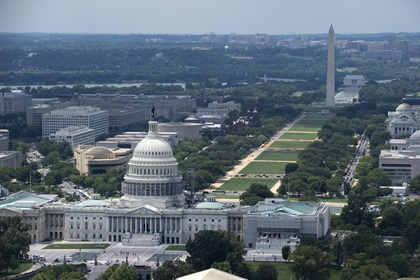
Despite my concerns of getting some unexpected formation time with an F-16, there was nothing to worry about. There is no reason to fear flying into the FRZ.
It’s easy to do as long as you have done your homework, gone through the process of getting a personal identification number (PIN) to fly into the “Maryland 3” airports – College Park Airport (CGS), Washington Executive/Hyde Field (W32) or Potomac Field (VKX), and use good piloting judgment.
I’m a VFR-only pilot who flies about 35 to 50 hours a year, mostly local $100 hamburger flights or short trips of less than 100 miles. I use flight following for cross-country flights, particularly if I’m transiting the busy New York Center area (I’m based in western New Jersey). On a rare occasion, for longer flights, I might file a VFR flight plan for the safety of search and rescue knowing where to look if I go down.
The reason I was flying to College Park was to attend the monthly meeting of the Free State Flying Club to learn about how they select new members (See this month’s Club Spotlight). The club has a Cessna 172 based at College Park, so all of its members must have a PIN and be familiar with flying in the FRZ and DC Special Flight Restriction Area (SFRA).
Flying in the SFRA
The DC SFRA, commonly pronounced “siffrah” was created after 9/11 and is a 30-nautical mile security ring around Washington, DC centered on Washington Reagan National Airport (DCA) with specific operating requirements and procedures. It includes the FRZ, which is an irregular-shaped inner ring, which is essentially a no-fly zone for GA. The exception is to get a PIN that allows a “known” pilot to file a flight plan into or out of one of the MD-3 airports.
To fly in the SFRA you need to do three things – complete the FAA DC SFRA course, file a SFRA flight plan, and be in contact with ATC and squawking a discreet transponder code until you are on the ground.
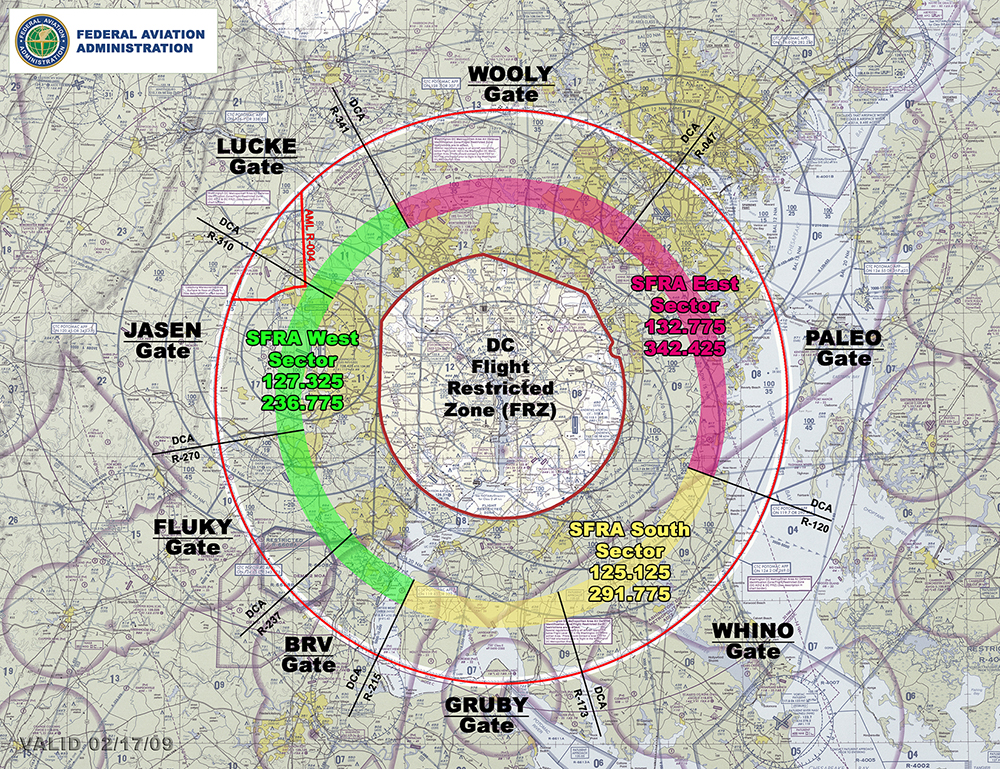
All pilots operating within 60 nm of Washington, DC need to complete the free SFRA course on www.faasafety.gov. It takes about 45 minutes and explains what the SFRA is, where it is, and what pilots must do to fly in the airspace. At the end of the course there is a short exam and upon passing you get a certificate that can be printed out. There are also kneeboard reference pages that can be printed and are useful to have with you in the cockpit.
The SFRA is broken up into three sectors – East, South, and West – each with its own frequency to contact ATC. There are eight gates, or areas of entry/exit. Each gate is a pie wedge, although they are not equal in size, and when filing a SFRA flight plan the gate of entry or departure must be identified. For my flight, I entered the SFRA from the east through the PALEO Gate.
If your destination or departure point is an airport within the SFRA, VFR pilots need to file a SFRA flight plan between the gate you will use to enter the SFRA and the destination airport. This is a separate flight plan that is distinct from a traditional VFR flight plan. Inbound traffic need to contact Potomac Center 5 to 10 miles before reaching the SFRA to activate their SFRA flight plan. Potomac Approach will provide a discreet transponder code, and once the transponder is observed, ATC will clear the pilot to enter the SFRA. Pilots must fly the most direct route from that point to their destination.
The process is exactly the same if you are flying into the FRZ, with the exception of how to file the flight plan. There is a special phone number designated for filing a FRZ flight plan. The briefer will ask for the pilot’s PIN and upon verification take the entry/exit gate information and destination/departure airport, along with the usual flight plan information.
About 10 years ago I took the online SFRA course so I could fly to Montgomery County Airport (GAI) in Gaithersburg, MD (which is in the SFRA but not the FRZ) to visit friends and family in the DC area. About a week before flying to College Park, I went online to review the course to make sure I was up to speed on the procedures for my first flight into the FRZ. At that point I learned the SFRA course has been updated several times. If you took the course before June 15, 2014 you need to take it again, as the original course is no longer valid.
Getting a PIN to Fly into the FRZ
The hardest part about flying into the FRZ is taking the time to get a PIN. I began the process to get my FRZ PIN about a year ago by attending an FAA Wings Seminar at the Lancaster Regional Airport (LNS) in PA. The Manager of Washington Executive/Hyde Field was giving the seminar and explained the process and paperwork needed to obtain a PIN. The PIN is issued through airport staff of either of the MD-3 airports. Because I went to the seminar given by the manager of Washington Executive, my PIN was issued through that airport. Your PIN is good at any airport, no matter which one issues it.
The requirements are fairly basic. You have to provide the following documentation:
· An FAA airman certificate
· An FAA medical certificate
· SFRA Training Course certificate
· A Maryland Three PIN Application – TSA Form 418 (signed)
· One form of government-issued picture ID
I provided some of this information to the Washington Executive Airport Manager at the Seminar and emailed scans/pdfs of the remaining documents to him. The TSA form is one page and simple to fill out.
You also must get fingerprinted for a background check, which is conducted through the National Air Transportation Association Compliance Services (NATACS). Its website, https://info.natacs.aero/maryland-three-program, has all the information on how to obtain a PIN number, the documents you need, and the email or snail mail addresses to send everything. Each of the MD-3 airport websites also have information on how to obtain a PIN, and I would suggest speaking with one of the MD-3 airport managers before you start filling out paperwork as they can guide you through the process.
I went to my local police department to get fingerprinted, paid a $35 fee – which may vary from police department to police department. There is a NATA fee of $30.75 or $65.75 depending on whether you use an outside agency or a NATA collector for the background check. I paid the $30 fee and mailed my completed fingerprints and forms to NATA. Once the paperwork is submitted and your background check completed, it goes to the airport you selected and the airport staff will call you to issue your PIN.
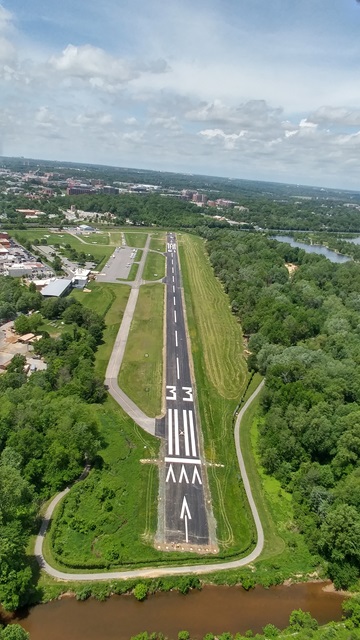
Planning My Flight
When planning the flight, I checked out the College Park Airport website, which had usual information about the airport, and filing a FRZ flight plan under the airport ops tab. There I found a pdf with step-by-step inbound/outbound instructions that I printed out.
I called Flight Service for a weather briefing and to file a VFR flight plan. I chose a direct route from Trenton-Mercer County Airport (TTN) in New Jersey following victor airways from the Yardley VOR just west of TTN, passing to the west of Philadelphia International (PHL) and directly over New Castle Airport (ILG) in Wilmington, DE to the SWANN intersection just outside of the Baltimore-Washington Bravo.
My thinking was flying an established route with a known waypoint would make it easier for reporting purposes when I need to activate my FRZ flight plan. From the SWANN intersection, my intention was to fly south to another marked reference point, Bay Bridge Airport (W29), just outside the SFRA and then turn west to enter through the PALEO Gate and continue into the FRZ flying directly to College Park.
After filing the VFR flight plan, I called the designated number for the Washington Center to file my FRZ flight plan. I was asked for my PIN, it was verified, and I filed a flight plan from the PALEO Gate to College Park.
Flight
The flight itself was uneventful. I departed from TTN around 3:15 pm on Runway 24, picked up flight following just past the Yardley VOR as I climbed to 6,500 feet and joined the victor airway. ATC vectored me to the west for departing traffic out of PHL and then back on course. There was a high, scattered cloud layer and calm winds for the flight. I was already talking with Potomac Center as I approached the SWANN intersection.
Without having to request activation of my FRZ flight plan, Potomac asked my intended route and gave me my new transponder code. I was instructed to stay clear of the Baltimore-Washington Class B and cleared into the SFRA. I turned south toward Bay Bridge Airport before reaching SWANN and descended to 2,500. I turned west at Bay Bridge, continued my descent to 1,200 to stay below the Bravo, and entered the SFRA through the PALEO Gate as I flew over the Annapolis Bay Bridge.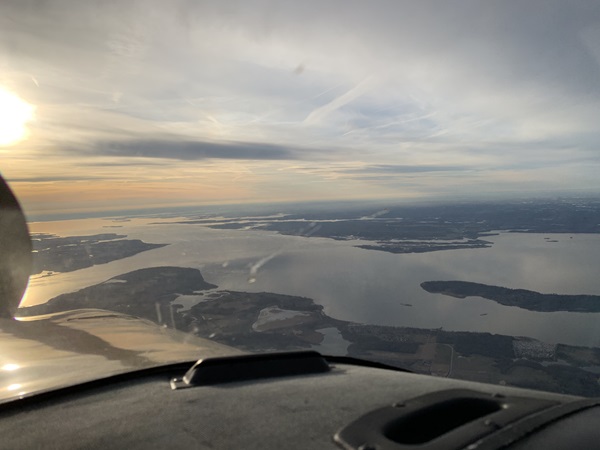
College Park can be a little tricky to find. There is a row of trees along the northside of the runway that keeps the airport a bit hidden, particularly at low altitude and with the late afternoon sun in my eyes. I saw the airport on what basically was a downwind for Runway 15. I called Potomac to inform ATC that I had the airport in sight, I was cleared to change frequency to the CTAF and to maintain the transponder code until I was on the ground.
I made a call to enter a crosswind for Runway 33, and received a response that Runway 15 was active along with a weather update. It’s always a nice touch when someone at the FBO is listening to the Unicom and provides helpful information, particularly since I was still looking for the windsock. I entered on the upwind and flew a standard pattern and landed on Runway 15.
I was met by Kyle from the FBO who helped push me back into a parking spot next to a Piper Meridian and began tieing down the plane as I was getting my bags out of plane. I’m not used to that kind of customer service. He also asked if I had a prop lock. They are required for all aircraft parked at the MD-3 airports. I don’t have one, but Kyle brought one out and put it on, which was much appreciated.
The excellent customer service continued when I was getting ready to depart the next day. Evan helped untie my plane so we could pull it to the fuel pumps. College Park doesn’t have self serve fuel, but if you pay by cash or check, you get a $0.15 cent discount per gallon.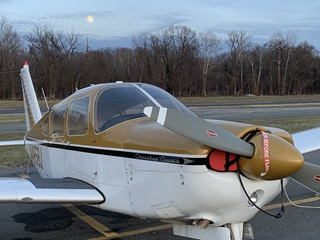
Departing the FRZ was as simple as the inbound procedures. I filed my FRZ flight plan from the FBO, and after my preflight, start-up checklists, and run-up were complete, I called Potomac TRACON from my cell phone in the cockpit to activate my flight plan. They cannot be reached by radio on the ground from College Park. I gave them my N# and requested clearance for departure, they assigned me a transponder code and gave me the departure frequency to contact once airborne.
After taking off on Runway 15 and getting clear of CGS, I called departure and they confirmed observation of my code and cleared me to proceed as filed – which was via Lee Airport (ANP) just southwest of Annapolis and then the PALEO Gate. Once leaving the SFRA, Potomac acknowledged exiting the SFRA, approved a frequency change and instructed me to squawk VFR. At that point, I requested flight following for the remainder of my flight and was given a new transponder code and away we went.
The experience of flying into the FRZ provided an opportunity to learn more about specialty airspace, sharpen my flight planning skills, and further develop my communication with ATC – flying a little more professionally than I normally do. Besides the addition of three airports that I may now fly into, flying into the FRZ has boosted my confidence knowing I have the skills and ability to safely fly where few pilots dare.
The moral of the story is, flying in restricted airspace, such as the Washington, DC FRZ, is not difficult to do. If your club members are interested in doing so, take the time to educate yourself on the airspace, go through the security process to get a PIN, and follow the procedures. By doing so, you’ll improve your piloting skills and open up a few additional airports as possible destinations to visit. Now that I’ve flown into College Park, I’m looking forward to going back next time I want to visit our Nation’s Capitol.